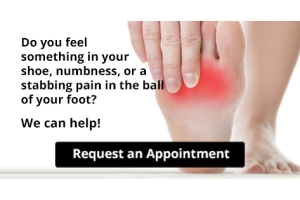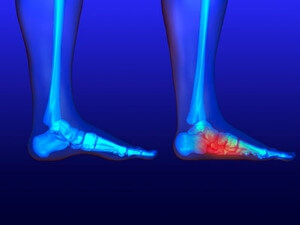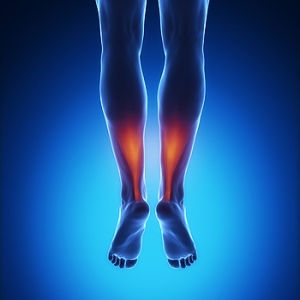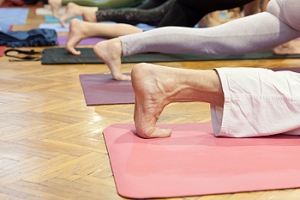Oceanside (760) 630-9200

How to Get a Proper Shoe Fit
Many people suffer from foot problems because their shoes are poorly fitted. When shopping for a new pair of shoes, fashion usually triumphs over comfortability. A pair of well fitted shoes is essential in preventing foot problems and potential injuries.
Poorly fitted shoes can cause foot issues such as plantar fasciitis, bunions, hammertoes, ingrown toenails, and foot pain. Shoes such as high heels and sandals may cause problems for your feet. These shoes put the foot in an unnatural position for long periods and fail to provide good foot support. It is recommended to not wear either one for an extended period.
When you are trying on shoes, make sure they have enough space for your toes to move around. Shoes shouldn’t be cramped but also shouldn’t have too much room that your foot moves around in them. A snug shoe is a good choice. They should also provide good arch support and cushioning. Athletic shoes tend to offer both good support and cushioning. A degree of flexibility is necessary so they aren’t too stiff or too unsupportive.
If you can wear your shoes for a long period of time without experiencing any discomfort, this is a sign that your shoes fit properly. Do not be too dismayed if the shoe isn’t a perfect fit at first; many shoes take a few days to weeks to properly break in. However don’t expect an uncomfortable shoe to become fitted to your foot.
For those with foot conditions such as flat feet or pronation, orthotics may be helpful or even necessary to prevent foot pain. Orthotics are inserts that are placed in the shoe and provide support and cushioning for the foot. While there are many types of orthotics out there, custom-made orthotics may be necessary depending upon your foot and foot conditions.
Feet change in size over time. It is important to check your foot size over time so that you can make sure you have the perfect fit for your feet. A podiatrist can provide more information on proper shoe fitting and foot orthotics.
Why Live with Pain and Numbness in Your Feet?
What Is Foot Overpronation?
 Pronation refers to the foot turning downward or inward as you walk or run. This is a normal component of a gait or walking pattern. In some people, however, the foot turns downward or inward too much, resulting in overpronation. This is a biomechanical problem that is particularly common among people with flat feet and can lead to foot and ankle problems such as plantar fasciitis and Achilles tendonitis. Runners and other athletes who have an overpronated gait are at an increased risk of foot and ankle injuries and often require specialized footwear or orthotics to help correct their gait and prevent injuries. If you suspect you may have an overpronated gait, a podiatrist can perform a gait analysis and determine the right course of treatment for you.
Pronation refers to the foot turning downward or inward as you walk or run. This is a normal component of a gait or walking pattern. In some people, however, the foot turns downward or inward too much, resulting in overpronation. This is a biomechanical problem that is particularly common among people with flat feet and can lead to foot and ankle problems such as plantar fasciitis and Achilles tendonitis. Runners and other athletes who have an overpronated gait are at an increased risk of foot and ankle injuries and often require specialized footwear or orthotics to help correct their gait and prevent injuries. If you suspect you may have an overpronated gait, a podiatrist can perform a gait analysis and determine the right course of treatment for you.
If you have any concerns about your feet, contact Dr. Jeff Brooks from Oceanside Foot & Ankle Center. Our doctor can provide the care you need to keep you pain-free and on your feet.
Biomechanics in Podiatry
Podiatric biomechanics is a particular sector of specialty podiatry with licensed practitioners who are trained to diagnose and treat conditions affecting the foot, ankle and lower leg. Biomechanics deals with the forces that act against the body, causing an interference with the biological structures. It focuses on the movement of the ankle, the foot and the forces that interact with them.
A History of Biomechanics
- Biomechanics dates back to the BC era in Egypt where evidence of professional foot care has been recorded.
- In 1974, biomechanics gained a higher profile from the studies of Merton Root, who claimed that by changing or controlling the forces between the ankle and the foot, corrections or conditions could be implemented to gain strength and coordination in the area.
Modern technological improvements are based on past theories and therapeutic processes that provide a better understanding of podiatric concepts for biomechanics. Computers can provide accurate information about the forces and patterns of the feet and lower legs.
Understanding biomechanics of the feet can help improve and eliminate pain, stopping further stress to the foot.
If you have any questions please feel free to contact our office located in Oceanside, CA . We offer the newest diagnostic and treatment technologies for all your foot and ankle needs.
Biomechanics in Podiatry
Podiatry is a branch of medicine that deals with the study, diagnosis, and treatment of foot and ankle conditions. There are various subdivisions in podiatry; biomechanics is one of them. Biomechanics is the way in which the bones, muscles, and joints of the feet and lower limb interact with each other.
Our feet play crucial roles in the way we move, and it is rare to have feet that are completely symmetrical. Common biomechanical issues include high or low arches or uneven leg heights. Excessive pronation often leads to fallen arches, or flat feet, and is a common cause of running injuries. People whose feet are over-pronated tend to have flexible and unstable feet. Pain is usually experienced during walking and running.
At times, people may be able to adapt to these abnormalities without any difficulties, but in other cases, these issues can cause a great deal of pain. This pain occurs because the joints, muscles, ligaments, and tendons are put under an excess amount of stress during movement. Common symptoms of biomechanical problems stemming from the feet include hip pain, knee pain, leg cramps, ankle pain, lower back pain, weak ankles, tripping, heel pain, Achilles pain, and shin splints.
Many biomechanical issues can be treated with orthotics. Orthotics are shoe insoles that are used to help control the way the foot operates. They can provide relief from foot pain, heel pain, and knee pain. Depending on your specific case, you may need to purchase over-the-counter orthotics or custom orthotics to fit your feet. Your podiatrist will be able to prescribe the perfect orthotic for your feet to help you walk around with ease.
Gait is defined as the way we move our bodies from one point to another. This is usually done by either walking or running. Gait analysis is a method used to assess the way we walk or run to highlight biomechanical abnormalities. Gait analyses are a great way to take a detailed look at how you walk and how your foot moves while you walk. An examination of the feet will help your podiatrist understand why you are suffering pain in other parts of your body.
Achilles Tendonitis Can Turn Into Tendonosis
 The Achilles tendon is a thick band of fibrous tissue located at the back of the lower leg. It connects the calf muscle to the heel bone and allows us to walk by raising the heel off of the ground. Repetitive stress placed on this tendon during activities such as running, playing high impact sports, and working on your feet can cause the tendon to become injured. Initially, the Achilles tendon may become inflamed in a condition known as Achilles tendonitis. An inflamed Achilles tendon can be painful, tender, and stiff. If left untreated, Achilles tendonitis could become chronic and lead to a degeneration of the tendon known as Achilles tendonosis. This condition makes the tendon lose its organized structure and makes it more likely to develop microscopic tears that cause chronic pain and may restrict mobility. Achilles tendonosis can also make a full rupture more likely. If you experience pain in your calf muscles, it is strongly suggested that you seek the care of a podiatrist who can diagnose and treat your condition and prevent further injury.
The Achilles tendon is a thick band of fibrous tissue located at the back of the lower leg. It connects the calf muscle to the heel bone and allows us to walk by raising the heel off of the ground. Repetitive stress placed on this tendon during activities such as running, playing high impact sports, and working on your feet can cause the tendon to become injured. Initially, the Achilles tendon may become inflamed in a condition known as Achilles tendonitis. An inflamed Achilles tendon can be painful, tender, and stiff. If left untreated, Achilles tendonitis could become chronic and lead to a degeneration of the tendon known as Achilles tendonosis. This condition makes the tendon lose its organized structure and makes it more likely to develop microscopic tears that cause chronic pain and may restrict mobility. Achilles tendonosis can also make a full rupture more likely. If you experience pain in your calf muscles, it is strongly suggested that you seek the care of a podiatrist who can diagnose and treat your condition and prevent further injury.
Achilles tendon injuries need immediate attention to avoid future complications. If you have any concerns, contact Dr. Jeff Brooks of Oceanside Foot & Ankle Center. Our doctor can provide the care you need to keep you pain-free and on your feet.
What Is the Achilles Tendon?
The Achilles tendon is a tendon that connects the lower leg muscles and calf to the heel of the foot. It is the strongest tendon in the human body and is essential for making movement possible. Because this tendon is such an integral part of the body, any injuries to it can create immense difficulties and should immediately be presented to a doctor.
What Are the Symptoms of an Achilles Tendon Injury?
There are various types of injuries that can affect the Achilles tendon. The two most common injuries are Achilles tendinitis and ruptures of the tendon.
Achilles Tendinitis Symptoms
- Inflammation
- Dull to severe pain
- Increased blood flow to the tendon
- Thickening of the tendon
Rupture Symptoms
- Extreme pain and swelling in the foot
- Total immobility
Treatment and Prevention
Achilles tendon injuries are diagnosed by a thorough physical evaluation, which can include an MRI. Treatment involves rest, physical therapy, and in some cases, surgery. However, various preventative measures can be taken to avoid these injuries, such as:
- Thorough stretching of the tendon before and after exercise
- Strengthening exercises like calf raises, squats, leg curls, leg extensions, leg raises, lunges, and leg presses
If you have any questions please feel free to contact our office located in Oceanside, CA . We offer the newest diagnostic tools and technology to treat your foot and ankle needs.
Achilles Tendon Injuries
The Achilles tendon is the largest tendon in the body; it is a tough band of fibrous tissue that stretches from the bones of the heel to the calf muscles. This tendon is what allows us to stand on our toes while running, walking, or jumping, it is common for this tendon to become injured. In severe cases, the Achilles tendon may become partially torn or completely ruptured. However, this tendon is susceptible to injury because of its limited blood supply and the high level of tension it endures.
The people who are more likely to suffer from Achilles tendon injuries are athletes who partake in activities that require them to speed up, slow down, or pivot. Consequently, athletes who engage in running, gymnastics, dance, football, baseball, basketball, or tennis are more likely to suffer from Achilles tendon injuries. Additionally, there are other factors that may make you more prone to this injury. People who wear high heels, have flat feet, tight leg muscles or tendons, or take medicines called glucocorticoids are more likely to have Achilles tendon injuries.
A common symptom of an Achilles tendon injury is pain above the heel that is felt when you stand on your toes. However, if the tendon is ruptured, the pain will be severe, and the area may become swollen and stiff. Other symptoms may be reduced strength in the lower ankle or leg area, and reduced range of motion in the ankle. When the Achilles tendon tears, there is usually a popping sound that occurs along with it. People who have acute tears or ruptures may find walking and standing to be difficult.
If you suspect you have injured your Achilles tendon, you should see your podiatrist to have a physical examination. Your podiatrist will likely conduct a series of tests to diagnose your injury including a “calf-squeeze” test. Calf squeeze tests are performed by first squeezing the calf muscle on the healthy leg. This will pull on the tendon and consequently cause the foot to move. Afterward, the same test will be performed on the injured leg. If the tendon is torn, the foot won’t move because the calf muscle won’t be connected to the foot.
Can Yoga Poses Help to Stretch the Feet?
 Many people suffer from sore feet at the end of the day. This can be a result of standing and walking for most of the day, or it may happen from wearing shoes that do not fit correctly. Many people overlook the health of the feet, and it is beneficial to frequently practice stretches that can enhance foot and body performance. Yoga poses can target the feet, and specific stretches can improve mobility and range of motion. The top of the feet can be stretched by performing a child's pose, and tension in the body is often released. The heel and Achilles tendon can be stretched by using a scarf that is wrapped around the feet. This is done while in a sitting position, and the feet are gently pulled toward you. The plantar fascia can be effectively stretched while kneeling back on the toes. As this is done, the bottom of the foot generally feels the complete stretch. If you would like additional information about the benefits of stretching the feet through yoga poses, please consult with a podiatrist who can determine which stretches are best for you.
Many people suffer from sore feet at the end of the day. This can be a result of standing and walking for most of the day, or it may happen from wearing shoes that do not fit correctly. Many people overlook the health of the feet, and it is beneficial to frequently practice stretches that can enhance foot and body performance. Yoga poses can target the feet, and specific stretches can improve mobility and range of motion. The top of the feet can be stretched by performing a child's pose, and tension in the body is often released. The heel and Achilles tendon can be stretched by using a scarf that is wrapped around the feet. This is done while in a sitting position, and the feet are gently pulled toward you. The plantar fascia can be effectively stretched while kneeling back on the toes. As this is done, the bottom of the foot generally feels the complete stretch. If you would like additional information about the benefits of stretching the feet through yoga poses, please consult with a podiatrist who can determine which stretches are best for you.
Stretching the feet is a great way to prevent injuries. If you have any concerns with your feet consult with Dr. Jeff Brooks from Oceanside Foot & Ankle Center. Our doctor will assess your condition and provide you with quality foot and ankle treatment.
Stretching the Feet
Stretching the muscles in the foot is an important part in any physical activity. Feet that are tight can lead to less flexibility and make you more prone to injury. One of the most common forms of foot pain, plantar fasciitis, can be stretched out to help ease the pain. Stretching can not only ease pain from plantar fasciitis but also prevent it as well. However, it is important to see a podiatrist first if stretching is right for you. Podiatrists can also recommend other ways to stretch your feet. Once you know whether stretching is right for you, here are some excellent stretches you can do.
- Using a foam roller or any cylindrical object (a water bottle or soda can will do), roll the object under your foot back and forth. You should also exert pressure on the object. Be sure to do this to both feet for a minute. Do this exercise three times each.
- Similar to the previous one, take a ball, such as a tennis ball, and roll it under your foot while seated and exert pressure on it.
- Grab a resistance band or towel and take a seat. If you are using a towel, fold it length wise. Next put either one between the ball of your foot and heel and pull with both hands on each side towards you. Hold this for 15 seconds and then switch feet. Do this three times for each foot.
- Finally hold your big toe while crossing one leg over the other. Pull the toe towards you and hold for 15 seconds. Once again do this three times per foot.
It is best to go easy when first stretching your foot and work your way up. If your foot starts hurting, stop exercising and ice and rest the foot. It is advised to then see a podiatrist for help.
If you have any questions, please feel free to contact our office located in Oceanside, CA . We offer the newest diagnostic and treatment technologies for all your foot care needs.















